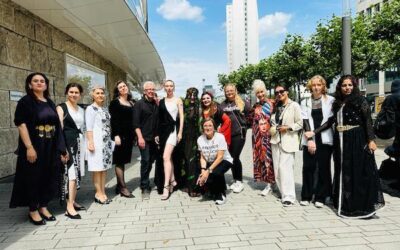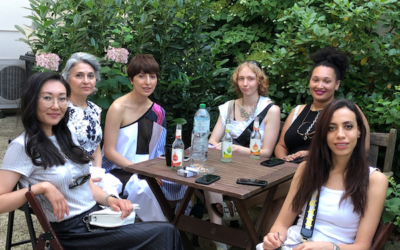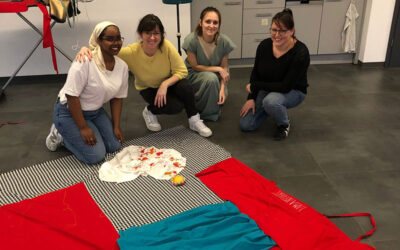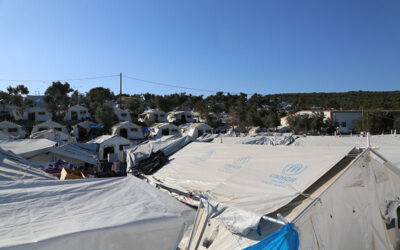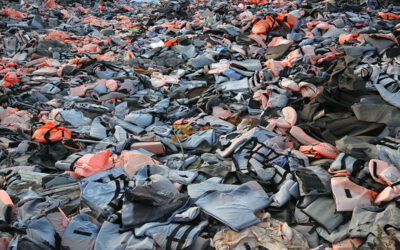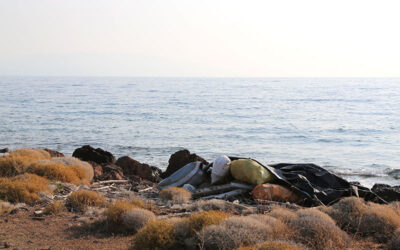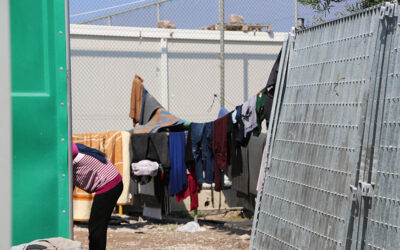Textile Touches of Escape and Migration
blog
EVENT AT THE DÜSSELDORF FASHION DAYS
The city of Düsseldorf supported our project with funding from the cultural office for the workshops and the economic development agency gave us an exhibition space for the Fashion Days. With the help of Diakonie Düsseldorf and the cooperation of many other people, we were able to realise the project work in the city centre for the Fashion Festival without a budget. A wonderful and new experience for me personally, because in the business of fashion and advertising, no project idea can be realised with pure humanity.
The presentation to the public for the DFD Festival Edition in the middle of the shopping zone during the fashion fair gave the participants an equal appreciation of their artistic work as well as their personal story. Being a woman without restrictions was not as normal for the participants with a recent history of flight as it is for us who live here. To represent an individual attitude through clothing as art was new and very special for all of them.
As designers, we learned a lot of new things about clothes from other cultures and were able to pass them on in conversations at the fashion event. Through fashion, art and clothing, we entered into an exchange with passers-by of all ages and social classes. Integration and migration as polarising topics in our society found an unusual and harmonious place of communication at our stand. The special nature of the dress-art works in the fashion context of the Düsseldorf trade fair offered us a platform with a particularly respectful approach.
A ballet production by the HHU Ballet Company supported our event with expressive dance, attracting the attention of passers-by to our exhibition. Dark escape shirts from Irene’s original Lesbos idea transported the emotion of pain, turmoil and change through movement. Uwe Schimera had decorated his installation “EUROPA” on puppets, which was a permanent eye-catcher in front of our exhibition tent. This escape scenery formed the stage and background for the dance performance and became a fitting intro to our presentation of the individual dress-art works on busts or worn by the participants themselves.
As a purely acoustic programme item, the first articles from the Charter of Human Rights sounded across the square in German to illustrate our commonalities as human beings. Our participants also recited the articles of human rights in their respective mother tongues. In their self-created refugee dress, some read their own texts in German or in their mother tongue, forming the emotional highlight of our presentation.
The printed, personal texts accompanying the dress-art works provided additional exciting insights into the participants’ experiences. This performance got under the skin of our group as well as the interested audience, the professional buyers of the fashion fair and diligents of the city. Young students who experience their normality as migrants here told older people who experienced their childhood in war here that the “European refugee crisis” meant the “great chance for a future” for them in their home country. The exchange of different generations and nations on an emotional level on this Saturday in Düsseldorf made it possible to experience human rapprochement through fashion, art and communication in a natural and respectful closeness.
On 22 July, we staged our conclusion, so to speak, which was already clear after the first workshop: fears and emotions of an experienced flight and migration are absolutely similar and comparable. They are simply human emotions that transcend all national borders and cultures. This summer we experienced with our participants that simple humanity is a connection and bridge across all borders.
Birgit Schwitalla
The Workshop in Düsseldorf
Irene’s project felt completely different and completely right to me from the first moment.
Everything I had done so far in terms of jobs was not comparable – and everything I had experienced so far professionally, artistically and privately was applicable.
The stories of my family’s flight during the Second World War from the area near Odessa formed a good basis for the completely new, precious experience in the artistic approach to processing the topic of migration and integration. I have always paid my utmost respect to refugees, because in my eyes there is no more courageous step than leaving everything you are used to and love for the sake of freedom. To create a dress-art work with the tragedy of the flight theme from the formative stories of my childhood was certainly an ideal motivation at the beginning – but not a necessity when realising the multitude of emotions of our participants. Core words that emerged during our work found their way onto a shirt – many more ideas could be implemented. At some point.
Here in Düsseldorf, it was the special people who were immediately enthusiastic about Irene’s special project idea. My colleague and friend Uwe Schimera, who promised his support right from the first exchange and was reliably, emphatically and creatively on hand throughout the summer. Through him, his know-how and his fabrics, our results and experiences have taken on a special quality.
Sofia Sydow, our art therapist with extensive knowledge on a human, artistic, professional and international level, experienced and processed with us the emotional depth and diversity of the escape stories told by our participants from 13 countries.
Elke Wisse from the WELCOME POINT of the DIAKONIE DÜSSELDORF was also a supporting pillar of the realisation from the very first moment with her promise of the premises. With all her experience, contacts and her human closeness to refugees, she paved many paths for us professionally and personally as head of the location.
To introduce the workshops, we had seven decades of pure femininity aged 12 to 73 in the room. The mood around the topic of flight and migration reached us all with equal intensity in exchanges ranging from shared laughter to liberated weeping. Irene made emotion the focus of her project – and so we worked out the emotion around the individual experience and wrote it into a box that could be opened and closed at any time like a diary or treasure chest. Our joint creative work began with bright colours, native flags, different mother tongues and stories – we very quickly shared an emotional togetherness without knowing each other any better … and after a very short time met in a friendly bond while exchanging text and dress ideas and with the large selection of fabrics from Uwe’s studio stock. The women’s stories knew no limits in the conversations – even though everything they experienced was at the limits.
The magical flow of this first event carried us through all the hurdles of implementation in the following weeks. The sensitively and openly shared emotion of the first meeting silenced occasional emerging conflicts even before they arose. It was a friendly, peaceful atmosphere of mutual understanding. Where otherwise in comparable situations small misunderstandings would quickly end the cooperation, here in trusting togetherness new friendships found a beginning.
In mutual trust, female inspirations and textile, western couture material mixed with Arab, Persian, Russian, Bolivian, Azerbaijani, Kazakh, Iraqi, Kurdish, Moroccan, Algerian, Syrian, Ukrainian and German feelings of sadness, hope, dignity, fear and freedom. The different textures, colours and patterns transformed all the different sensations into new ideas and processing of clothing.
Ideas of unleashing and constriction, drawn words of protest and phrases of change and the past. Transformation of tradition and dystopia, from oppressive compulsion to fabulous simplicity, from protection to hope, from colourful cheerfulness to gloomy fear or simple beauty … All feelings could be freely expressed in a personal realisation.
Für uns als Begleiter:innen der Workshops war es eine wertvolle Erfahrung, die echte Stärkung mancher Frauen zu erleben, die sie durch die Gemeinschaft und vertrauensvolle Zusammenarbeit erfahren haben.
Birgit Schwitalla
A REPORT FROM THE STUTTGART WORKSHOP
Starting a new project is a bit like planning a trip – you prepare for a long time, decide on a direction to go, choose your companions and pack your suitcases. For this project, the suitcases contained sewing machines, fabrics, yarns, paints, brushes and various tools. The phase of preparation turned out to be quite long and extensive. Applications had to be made, funds requested and a suitable room found. When the journey – the project – really begins, good preparation is very helpful, but the most important thing is to get involved and trust the process. Because the creative process output is always uncertain.
We knew who had signed up, but who would actually come remained a surprise. On the first weekend, fewer participants came than planned, but it turned out that this was more of an advantage, as it proved to be more of a challenge to explain the content and goal of the project. The questions that were provided on the website as an orientation helped to approach the topic, even if it was not easy to work on them due to the language barrier. Over time, however, we found a good way to communicate with each other and the first drafts emerged. Shopping together at the fabric store rounded off the first day and allowed us to get really active the next day. While we were working together, interesting conversations kept arising, as far as it was linguistically possible, and we learned something about the history of the women, to the extent that they were willing to open up, and one could perceive a first tender feeling of trust.
On the second weekend of the project, we already met with a greater familiarity and began with a comfortable round of talks. Due to the train strike, we were again fewer participants than expected, but this allowed us to turn more extensively to those present, and we found that this was useful and also necessary. We talked with them about their current situation, support possibilities, but also about how to deal with racism, rejection and fears. The group had already grown together noticeably and we could perceive that this gave the participants support and security. The artwork progressed and at the end of the weekend we were very proud of the exhibits we had created.
Now we have one last deadline coming up, and we’re looking forward to seeing the participants again and finishing the artwork. Looking back, I can say for myself that I am very happy to have gotten involved in this project. Through which medium one makes use of the creative forces within is perhaps not so important – through the one that was given, it worked very well in my perception. By working on the artworks, we were able to give the participants a way to gently approach their inner themes and express them in their own way. It is not excluded that this also reveals and awakens painful parts, but we had the impression that we were able to catch these dark moments well and support the participants in their processes in such a way that it became a positive experience for everyone. A central moment in dealing with the issue of “flight” is loneliness, and the experience of an attuned, benevolent group can alleviate this, at least for a while.
Personally, I take away from this project a deep reverence for these women who, with incredible courage and perseverance, hold their own in a world that is often not kind to them. And also for those who never tire of supporting all those who need help. There is a special magic when people begin to communicate with each other without language, on a level before words come into being. Since the creation of art is also on this level, I found the project to be very coherent and well-functioning, and we received exactly this feedback from the participants – coupled with the desire to repeat or continue it.
Sarah Mast, art therapist, Stuttgart
THE PANDEMIC IS OVER
The pandemic is over and finally workshops can take place.
From the beginning, Textile Touches was planned to bring together people with very different experiences and from very different backgrounds in shared workshop spaces. Meeting the other while working creatively on the same theme is what I wanted to initiate. The first ones are now taking place in Stuttgart, which makes me very happy.
I am working on having many more in other cities.
Although flight always has sad causes, I still imagine that there will be garment artworks that show very diverse emotions and experiences. Perhaps there is joy at having met someone who enriches one’s life. Or there is interesting friction taking place.
Obviously, flight, migration and integration will continue to surround us in the years to come. With the war in Ukraine, the topic is closer than ever for me personally. My deepest wish is to transform the stranger into a friend.
Irene Schüller, initiator of the project
INVITATION TO PARTICIPATE IN THE COLLECTION OF LIFE VESTS
Because I receive an endless supply of office shirts at no cost, I began wondering what I could do with them. One woman in Moria explained to me that black clothes are particularly helpful while fleeing to safety, since you can hide better by night. The form was intended to depict a life vest, the quintessential symbol of flight over the Mediterranean Sea. I colored the shirts black, so that the fabric could serve as the starting point for vests. Because I used a plant-based dye, the result was more purple than black. As it happens, purple as a symbolic color for transformation proved an even more appropriate theatrical statement for this project. Seamstress Inessa Reifschneider sewed an initial version of the vest to serve as a prototype.
Those interested in taking part in serial production of purple life vests are invited to bring dyed, pre-worn office shirts to the studio. You are naturally welcome to perform the dyeing yourself (please use only plant-based dyes). Experience dictates that used shirts can be found in any second-hand store.
Irene Schüller, initiator of the project
EXPERIENCES ON THE SHORES
It wasn’t until I got to Lesbos that I became clear that the refugee situation on the Greek islands presented ecological challenges as well. Many of the tools they used to flee were abandoned on the shores. NGOs try to help through beach cleaning campaigns. In the northern part of the island, there was a collection point for abandoned flotation devices — a ‘life vest graveyard’ — and various ideas about reworking these into things like handbags or wallets.
Irene Schüller, initiator of the project
MY CONTRIBUTION TO THE EXHIBIT
In the initial months after my return from Lesbos, I did some experimenting using the sewing machine. I wasn’t particularly pleased with the results. With the support of costume designer Gesine Habermann from Frankfurt, I created my own piece for the exhibit, under the title “Long Time no See.” The clothing artwork itself, a set of photographs and a documentary film to accompany it were already available for viewing in Freiburg at the Karl Rahner Haus (Link to “Long Time No See”). It will also initially be available for visitors to try on in “Textile Touches of Escape and Migration.”
Irene Schüller, initiator of the project
EXPERIENCES IN MORIA AND THE CLOTHING CIRCUIT
I chose not to publish photos of the people with whom I’d had such close contact and who recounted their stories, often highly personal; this seemed like a necessary step to protect their privacy. Yet one story in particular touched me deeply, and I feel the need to share it here. It was the story of a young Afghani woman, herself a fashion designer! She fled Afghanistan because her parents had married her to a man thirty years her senior, to be his fifth wife. In love with a boy her own age, she fled to Iran, where she successfully completed a program in fashion design and went to work designing for film and television. When her family tracked her down, she was forced to go underground, as otherwise she would have been stoned to death for adultery.
It quickly became clear to me that of the individuals I met in the Moria camp, nearly none were still wearing their original clothing. Clothing had had to be swapped out at multiple stations along the route (from Afghanistan, Syria, North Africa… to Moria) . The refugees who were picked up at the time by Frontex or other NGOs and brought to Lesbos generally gave up their wet garments when first entering the camp, and were immediately provided with dry ones. To be more precise: with dry clothing that had been left behind by other refugees and which, having been washed, were now being provided to the new arrivals. A clever system that contributed to people perpetually slipping into a new clothing identity.
Irene Schüller, initiator of the project

